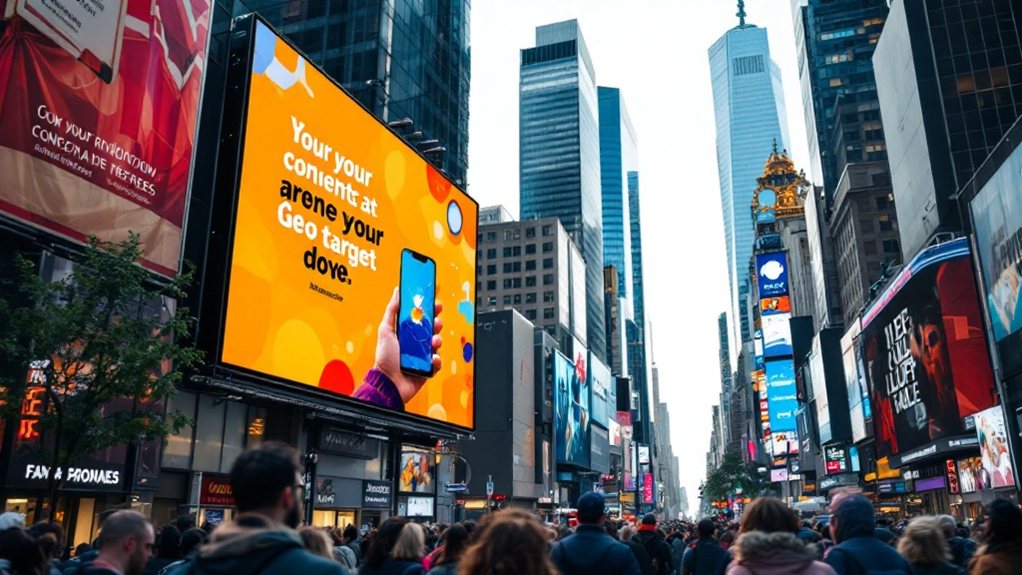Geo-targeted content leverages your location to personalize messaging, boosting relevance and engagement. It helps you deliver the right content to the right people in the right place, optimizing marketing strategies and cutting costs. By tailoring content to local interests and needs, you can forge deeper connections with your audience and outperform competitors. To dive deeper into the significance and applications of geo-targeting, continue exploring the outline provided.
Understanding Geo-Targeted Content

Geo-targeted content is a powerful marketing strategy that allows you to tailor your messaging to users based on their geographic location. This method utilizes geolocation software to identify users' locations via IP addresses, device IDs, or other means. Maintaining an up-to-date list of search engine crawler IP addresses is challenging for cloaking. By delivering personalized content that aligns with local interests and needs, you can enhance its relevance and effectiveness, helping you focus your marketing efforts efficiently. Geo-targeting is widely used in sectors like retail, advertising, and local services to improve customer engagement and conversion rates. To succeed, you must develop content that aligns with local languages, traditions, and preferences, and dynamically adjust it based on users' locations.
The Significance of Geographical Relevance

Geo-targeted content leverages the power of location to heighten engagement and effectiveness. By tailoring your messaging to users' proximity, you can create a more personalized and relevant experience. Geo-targeting recognizes the user's location and customizes content, such as deals and ads, specifically for their local area. This hyper-local approach can significantly improve the impact of your marketing efforts.
Local Targeting Effectiveness
The power of local targeting lies in its ability to resonate with your target audience on a deeper level. By leveraging geo-specific insights, you can craft content that truly speaks to the unique needs and preferences of your local community. This not only boosts engagement but also drives tangible results, from increased sales to enhanced customer loyalty.
Consider the benefits:
- Heightened Relevance: Local content addresses the specific pain points and interests of your target audience.
- Improved Visibility: Geo-targeted optimization ensures your business stands out in local search results.
- Stronger Connections: Personalized messaging fosters a deeper sense of community and trust.
- Cost Efficiency: Laser-focused campaigns maximize your marketing budget and return on investment.
- Hyperlocal targeting can cut the cost per install (CPI) by as much as 50%.
Proximity-Based Engagement
Proximity-based engagement takes local targeting to the next level. By leveraging location data, you can deliver hyper-relevant messages to consumers based on their physical proximity to your business. This allows you to connect with potential customers at the right time and place, enhancing their experience and boosting engagement. The global pandemic delivered a tremendous blow to the spa and beauty industry. Geofencing, beacons, and NFC enable precise targeting, while retargeting helps maintain that connection even after they leave the area. Integrating customer data and real-time analytics empowers you to personalize these interactions, fostering deeper loyalty. However, you must balance personalization with privacy by ensuring transparent opt-in mechanisms. Approached strategically, proximity-based engagement can give you a competitive edge in today's market.
Tailoring Marketing Strategies With Geo-Targeting

Geo-targeting allows you to personalize your marketing campaigns, optimizing resource allocation and boosting engagement. By delivering localized, relevant content, you can drive higher conversions and better connect with your target audience. Geo-targeting aims to ensure the marketing message reaches the right people in the right place, which heavily impacts the relevance and success of the campaigns. Harnessing the power of geo-targeting can give your marketing efforts a significant advantage in today's competitive landscape.
Personalized Campaigns Boost Engagement
Although personalization is crucial for engaging today's consumers, geo-targeting takes it a step further by tailoring your marketing strategies to the specific needs and interests of local audiences. Consumers are 71% more likely to engage with ads that align with their habits and interests, boosting interaction and click-through rates. Geo-targeted content helps you build stronger relationships with your target audience through:
- Increased relevance and resonance with local customers
- Higher in-store visits and reduced ad waste
- Insights to refine your strategies based on real-time performance data
- More effective competition with larger brands in your local market
- Demonstrating the validity of the content relative to the local search terms used.
Geotargeting Optimizes Resource Allocation
Optimizing your resource allocation is a key benefit of geo-targeting. By leveraging geographical data, you can focus your marketing efforts on high-potential regions, reducing waste and maximizing your return on investment (ROI). Geo-targeting facilitates more accurate ROI analysis, allowing for better decision-making. This approach enables you to identify specific target audiences, minimize unnecessary spending, and develop a competitive advantage through location-specific content. Moreover, geo-targeting facilitates more accurate ROI analysis, allowing for better decision-making.
| Resource Efficiency | Targeted Audiences | Cost Minimization |
|---|---|---|
| Geo-targeting allows you to allocate resources more effectively. | Geographic data helps you identify engaged audiences. | Tailoring strategies for specific locations reduces unnecessary spending. |
| Competitive Advantage | Enhanced ROI Analysis | |
| Location-specific content resonates with local audiences. | Geo-targeting attributes success/failure to geographic areas. |
Localized Relevance Drives Conversions
Tailoring your marketing strategies with geo-targeting can really pay off. By delivering location-based content, you increase the relevance for your local customers, boosting engagement and driving conversions. Geotargeting uses IP addresses, GPS, Wi-Fi, and other data to display content in specific locations. Here's how it works:
- Personalized Offers: Geo-targeted content allows you to showcase personalized offers and promotions that are more likely to resonate with your audience.
- Higher User Engagement: Consumers are more invested in content customized to their location, leading to greater interaction and potential sales.
- Streamlined User Experience: Geo-targeting ensures your marketing efforts reach the right people at the right time, optimizing the customer journey.
- Improved ROI: Targeted campaigns yield higher conversion rates and a better return on your marketing investment.
Enhancing User Engagement Through Personalization
Personalization lies at the heart of enhanced user engagement. By tailoring content and experiences to the unique needs and preferences of local audiences, geo-targeted content creates more meaningful interactions. Adapting messaging, visuals, and offerings to specific cultural contexts fosters deeper connections. Responsive design ensures seamless accessibility across devices, while community-focused initiatives cultivate a sense of belonging. Insights into local behaviors and interests empower marketers to refine strategies dynamically. This adaptability, coupled with data-driven optimization, maximizes impact and return on investment. Ultimately, geo-targeted personalization elevates the user experience, driving increased engagement, conversions, and brand loyalty – essential elements for success in today's hyper-local digital landscape.
Maximizing Cost-Efficiency in Advertising
When it comes to maximizing cost-efficiency in advertising, geo-targeting is a game-changer. By focusing your ads on specific geographic areas, you can reduce wasteful spending on audiences unlikely to convert, optimize your campaign budgets, and achieve better ROI. Geotargeting provides a powerful combination of behavior and location data for a tailored, contextual experience. Leveraging the power of location-based targeting can give your business a competitive edge and help you reach the right customers more effectively.
Targeted Ad Placement
One of the keys to maximizing cost-efficiency in advertising lies in targeted ad placement. By leveraging location-based targeting, you can deliver ads tailored to a user's current or recent location, boosting relevance and real-time engagement. Additionally, content adaptation allows you to customize ads with different languages, currencies, offers, and visuals for specific markets. Tapping into the power of AI and machine learning further refines your ad targeting, making predictions more precise and enabling real-time campaign adjustments. Finally, platforms like Google Ads and Facebook provide robust tools for precise audience targeting, retargeting, and in-depth data analysis to optimize placements for maximum reach and ROI.
Reduced Advertising Waste
By leveraging the power of geotargeting, you can reduce advertising waste and maximize the cost-efficiency of your marketing campaigns. Geotargeting allows you to focus on specific geographic locations, ensuring your ads reach the intended audience and eliminating unnecessary exposure. This targeted approach minimizes wasted impressions, reduces your cost-per-click, and increases engagement rates. With geotargeting, you can tailor your messaging to match local contexts, preferences, or events, enhancing relevance and driving better results. By focusing on high-conversion areas, you can optimize your ad spend and justify advertising costs through increased engagement and ROI. Geo-targeted content empowers data-driven decision-making, enabling real-time adjustments to further optimize your campaigns.
Optimized Campaign Budgets
Optimized campaign budgets are key to maximizing cost-efficiency in your advertising efforts. By focusing on targeted geographic areas, you can achieve significant increases in ROI, cost savings, and enhanced performance metrics. Leveraging advanced geo-targeting features on platforms like Google Ads and social media can deliver:
- Hyper-local targeting to attract local foot traffic and boost engagement
- Personalized messaging that resonates with your audience's local needs and interests
- Location-specific offers that increase customer responsiveness
- Real-time analytics to monitor and optimize campaigns based on live data
Effective geo-targeting empowers you to allocate budgets smartly, scale performance-based, and make data-driven decisions for maximum impact.
Leveraging Geo-Targeting for Competitive Advantage
Geo-targeting empowers businesses to gain a competitive edge by tailoring their marketing efforts to specific geographic areas. By focusing on local trends, events, and consumer preferences, you can differentiate your brand and optimize your resources. This strategic approach enhances your relevance, engagement, and conversion rates, ultimately driving better business outcomes.
| Competitive Advantages | Targeted Strategies | Measurable Impact |
|---|---|---|
| Niche Targeting | Capitalize on underserved markets | Increased market share |
| Localized Branding | Establish a strong local presence | Improved brand loyalty |
| Regulatory Compliance | Adhere to evolving data privacy laws | Mitigate legal risks |
Leveraging geo-targeting gives you the insights and flexibility to outmaneuver your competitors and forge deeper connections with your local customers.
Improving Local Search Engine Optimization
Leveraging geo-targeted content is key to improving your local search engine optimization (SEO) efforts. By tailoring content to specific geographical locations, you can enhance the relevance of your pages to local audiences, boosting your visibility in local search results. This approach helps you:
- Increase relevance to local search queries, improving your search engine rankings.
- Enhance user experience by providing location-specific information that matches their needs.
- Boost engagement by making your content more accessible and appealing to local audiences.
- Drive significant improvements in your local SEO success by creating more targeted and impactful marketing campaigns.
Applying Geo-Targeting Across Digital Platforms
As you leverage digital platforms to expand your reach, applying geo-targeting can be a game-changer. By harnessing the power of location-based data, you can deliver highly personalized content and ads, ensuring your message resonates with the right audience.
Whether it's Facebook Ads, Instagram Ads, or Snapchat Ads, geo-targeting allows you to laser-focus your efforts, maximizing engagement and driving conversions. Similarly, in native advertising, platforms like Taboola and Outbrain offer geo-targeting capabilities, enhancing the contextual relevance of your content.
| Platform | Geo-Targeting Feature |
|---|---|
| Google Ads | Radius targeting and location exclusions |
| Bing Ads | Location targeting and language optimization |
| Foursquare Ads | Location and user check-in history targeting |
Embracing geo-targeting across your digital marketing strategy can unlock unprecedented levels of personalization and effectiveness, transforming the way you connect with your local audience.
Overcoming Challenges in Geo-Targeting Implementation
While geo-targeting can unlock powerful personalization, it's not without its fair share of challenges. From inaccurate location data to platform variability, marketers must navigate a complex landscape to deliver relevant content. Consider these key hurdles:
- Granular Targeting: Precise targeting requires carefully excluding irrelevant locations, a delicate balance to avoid wasted ad spend.
- Technical Integration: Integrating multiple platforms complicates data tracking and optimization, and the rise of mobile has made location data less readily available.
- Localization: Crafting content that resonates with local audiences based on language, culture, and norms is crucial but time-consuming.
- Privacy Concerns: Adhering to regulations while maintaining effective targeting is an ongoing challenge that requires a deft, privacy-first approach.
The Future of Geo-Targeted Content Delivery
The future of geo-targeted content delivery holds immense promise, as cutting-edge technologies continue to revolutionize the way marketers connect with their audiences. Smart city initiatives will unlock innovative location-based advertising opportunities, while advancements in voice-activated strategies will enable seamless integration with consumers' daily lives. As 5G connectivity enhances signal penetration, geo-fencing and mixed reality experiences will become even more precise and immersive. Predictive analytics powered by AI will leverage environmental context and behavioral data to deliver dynamic, personalized content, optimizing budgets and unifying the brand experience across online and offline channels. The future of geo-targeting is poised to transform customer engagement, making every interaction highly relevant and memorable.
